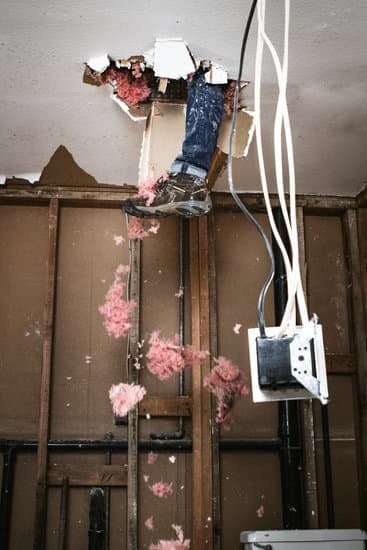Can you deduct improvements to home for medical reasons? Medical expense deductions can provide tax benefits for individuals who have made necessary home improvements for medical reasons. These deductions can help offset the costs of specific renovations, making it essential to understand the criteria and requirements for qualifying.
To qualify for the medical expense deduction, certain criteria must be met, including eligibility of home improvements. Specific examples of deductible home improvements for medical reasons include wheelchair ramps, stairlifts, and widened doorways. The importance of proper documentation and proof of medical necessity for these home improvements cannot be overstated in order to qualify for the deduction.
Exploring any limitations or restrictions on the types of home improvements that can be deducted for medical reasons is crucial, as well as understanding potential tax implications. It is important to consult with a tax professional or accountant for personalized advice and guidance on how to claim the deduction on your tax return. Understanding these important details will help individuals make informed decisions regarding their medical expense deductions and home improvements.
Qualifying for the Medical Expense Deduction
To qualify for the medical expense deduction, there are certain criteria that must be met. This deduction allows taxpayers to deduct medical expenses that exceed a certain percentage of their adjusted gross income. In order to claim this deduction, the taxpayer must itemize their deductions using Schedule A of Form 1040. The following criteria must be met in order to qualify for the medical expense deduction:
- The total medical expenses must exceed 7.5% of the taxpayer’s adjusted gross income. For example, if your adjusted gross income is $50,000, you can only deduct medical expenses that exceed $3,750.
- Only qualified medical expenses are eligible for the deduction. This includes a wide range of eligible expenses such as doctor’s fees, prescription medication, and necessary hospital services.
- Home improvements for medical reasons can also qualify as deductible medical expenses. This includes modifications made to the home to accommodate a disability or chronic illness.
In addition to meeting these criteria, it is important to keep detailed records and documentation of all medical expenses, including home improvements for medical reasons. Proper documentation and proof of medical necessity are crucial when claiming the medical expense deduction on your tax return.
Overall, qualifying for the medical expense deduction requires careful consideration and record-keeping. Consulting with a tax professional or accountant can provide personalized advice and guidance on navigating the eligibility criteria and maximizing potential tax benefits when deducting home improvements for medical reasons.
Please note that individual circumstances may vary, so it is important to seek professional advice regarding specific eligibility and requirements for claiming the medical expense deduction and home improvements for medical reasons on your tax return.
Examples of Home Improvements for Medical Reasons
When it comes to deducting home improvements for medical reasons, there are specific examples of modifications that may qualify for the medical expense deduction. These include wheelchair ramps, stairlifts, and widened doorways. These types of improvements are considered medically necessary and can significantly enhance the mobility and accessibility of individuals with disabilities or medical conditions.
Wheelchair ramps are a common example of a home improvement that may be deductible for medical reasons. Installing a wheelchair ramp can make it easier for individuals with mobility issues to enter and exit their homes safely. The cost of both the materials and labor required to construct the ramp can potentially be included as part of the medical expense deduction.
Similarly, stairlifts are another example of a home improvement that may qualify for the deduction. Stairlifts provide a safe and convenient way for individuals with mobility challenges to navigate multiple levels within their homes. The purchase and installation costs associated with stairlifts can be considered eligible expenses under the medical expense deduction if they are deemed medically necessary.
Finally, widening doorways to accommodate wheelchairs or other assistive devices is another example of a home improvement that can be deductible for medical reasons. Modifying doorways to allow for easier access throughout the home can greatly improve the quality of life for individuals with disabilities or medical conditions. The costs associated with widening doorways can potentially be included in the medical expense deduction if they are considered medically necessary.
| Medical Expense Deduction Example | Potential Deductible Costs |
|---|---|
| Wheelchair Ramp | Materials and labor required to construct the ramp |
| Stairlift | Purchase and installation costs |
| Widened Doorways | Costs associated with modifying doorways |
In order to determine whether specific home improvements qualify for the medical expense deduction, it is important to consult with a tax professional or accountant who can provide personalized guidance based on individual circumstances. Additionally, proper documentation and proof of medical necessity will be crucial in supporting any claims for these deductions on your tax return.
Documentation and Proof
Proper documentation and proof are crucial when it comes to deducting home improvements for medical reasons. Without the necessary evidence of medical necessity, you may not be able to claim the deduction on your tax return. Here are some key points to keep in mind regarding documentation and proof:
- Medical Necessity: It is essential to have a clear and detailed explanation from a qualified medical professional regarding the necessity of the home improvement. This can include a letter from your doctor or healthcare provider outlining the specific medical condition that requires the home improvement.
- Receipts and Invoices: Keep all receipts and invoices related to the home improvement project, including materials, labor costs, and any other expenses incurred. These documents serve as evidence of the actual cost of the improvement.
- Before-and-After Documentation: Providing before-and-after photos or detailed descriptions of the living situation before and after the home improvement can help support your case for medical necessity.
By maintaining thorough documentation and proof of medical necessity for home improvements, you can increase your chances of successfully claiming the deduction on your tax return.
It’s important to note that failure to provide adequate documentation may result in the IRS disallowing the deduction for home improvements for medical reasons. Therefore, it is in your best interest to gather and retain all relevant documentation and proof in an organized manner.
Consulting with a tax professional or accountant can also be beneficial in ensuring that you have all necessary documentation and proof in place to support your claim when deducting home improvements for medical reasons. They can provide guidance on what specific documentation is required and how to properly present it when filing your taxes.
In summary, proper documentation and proof of medical necessity play a critical role in qualifying for the deduction of home improvements for medical reasons. By following these guidelines and seeking professional advice if needed, you can maximize your chances of successfully claiming this valuable tax benefit.
Limitations and Restrictions
When it comes to deducting home improvements for medical reasons, there are certain limitations and restrictions that individuals need to be aware of. While the IRS does allow for certain home improvements to be deducted as medical expenses, there are specific criteria that must be met in order to qualify.
One of the key limitations is that the home improvements must be deemed medically necessary in order to alleviate or prevent a physical or mental illness. This means that not all home improvements will qualify for the deduction, and it is important to carefully consider whether an improvement truly meets the criteria.
In addition to the requirement of medical necessity, there may also be restrictions on the size or scope of the home improvement that can be deducted. For example, while installing a wheelchair ramp may qualify as a deductible expense, constructing an entire new wing of a house specifically for medical purposes may not meet the criteria.
It’s important to carefully review the specific guidelines and regulations set forth by the IRS in order to determine what types of home improvements can be claimed as medical expenses.
Another limitation to consider is that any improvement made for personal aesthetic reasons, rather than for medical necessity, would not qualify for the deduction. This means that if a homeowner chooses to make renovations purely for comfort or convenience rather than directly related to a medical condition, those expenses would not meet the criteria for a medical expense deduction.
It’s important for taxpayers to understand these limitations and restrictions before claiming deductions for home improvements made for medical reasons. Ensuring that any claimed deductions meet all necessary requirements can help avoid potential issues with tax audits and ensure compliance with IRS regulations. Consulting with a tax professional can provide valuable guidance on navigating these limitations and restrictions when deducting home improvements for medical reasons.
Tax Implications
When it comes to deducting home improvements for medical reasons, there are important tax implications that individuals need to consider. Understanding the potential tax benefits and consequences of these deductions is crucial for making informed decisions and maximizing any available tax relief.
Potential Tax Benefits
Deducting home improvements for medical reasons
This can lead to valuable savings for homeowners who have incurred substantial medical expenses and made necessary modifications to their homes. Additionally, those who qualify for the medical expense deduction may be able to benefit from a lower adjusted gross income (AGI) and potentially qualify for other tax credits or deductions.
Potential Tax Consequences
While there are potential tax benefits associated with deducting home improvements for medical reasons, it’s important to be aware of any potential tax consequences. Individuals must ensure that they meet all criteria and documentation requirements set forth by the IRS in order to avoid potential audit issues or penalties. Additionally, claiming these deductions could impact other tax calculations or phase-out thresholds, so it’s crucial to fully understand the potential implications on one’s overall tax situation.
Consultation With a Tax Professional
Given the complexities surrounding tax implications related to deducting home improvements for medical reasons, it is strongly recommended that individuals consult with a qualified tax professional or accountant. A skilled professional
They can help navigate the intricacies of these deductions, maximize any available benefits, and ensure compliance with IRS regulations. Ultimately, seeking expert assistance can provide peace of mind and help individuals make well-informed decisions when it comes to claiming these deductions on their taxes.
How to Claim the Deduction
When it comes to claiming the deduction for home improvements for medical reasons on your tax return, there are specific steps you need to follow in order to ensure that you are taking full advantage of the potential tax benefits. The first step is to itemize your deductions using Form 1040, Schedule A. This is essential because the medical expense deduction is only available to those who itemize their deductions, rather than taking the standard deduction.
Next, you will need to calculate your total medical expenses for the year. This includes all eligible medical expenses, including any home improvements made for medical reasons. It’s important to keep detailed records and receipts of these expenses, as proper documentation is crucial when claiming the deduction.
After calculating your total medical expenses, you can then determine whether they meet the threshold for deductibility. As of 2021, you can only deduct qualifying medical expenses that exceed 7.5% of your adjusted gross income (AGI). If your total medical expenses exceed this threshold, you can include them as part of your itemized deductions on Schedule A.
Finally, when completing your tax return, be sure to carefully follow the instructions for reporting medical expenses and any home improvements made for medical reasons. The IRS provides specific guidance on how to report these expenses on Form 1040 and Schedule A. Failing to accurately report these expenses could result in errors on your tax return and potential penalties from the IRS.
It’s important to note that claiming a deduction for home improvements for medical reasons requires careful consideration and adherence to IRS guidelines. Consulting with a tax professional or accountant is highly recommended in order to ensure that you are maximizing your potential tax benefits while remaining in compliance with federal tax laws.
Consultation With a Tax Professional
In conclusion, determining whether you can deduct improvements to your home for medical reasons can be a complex process, but it is an important one for those who have incurred significant medical expenses. By understanding the basics of medical expense deductions and the criteria for qualifying, individuals can determine if their home improvements may be eligible for a tax deduction.
It is crucial to keep accurate documentation and proof of medical necessity for any home improvements in order to support the deduction claim.
While there are limitations and restrictions on the types of home improvements that qualify for a deduction, it is important to consult with a tax professional or accountant for personalized advice. They can provide guidance on how to claim the deduction on your tax return and navigate any potential tax implications. A tax professional has a deep understanding of tax laws and regulations, and can ensure that you are maximizing your potential deductions while remaining in compliance with IRS guidelines.
Overall, consulting with a tax professional is highly recommended when considering deductions for home improvements for medical reasons. Their expertise can help individuals make informed decisions and take advantage of any available tax benefits while avoiding potential consequences or penalties. Deductions related to medical expenses and home improvements require careful consideration and proper guidance, making the expertise of a tax professional invaluable in these matters.
Frequently Asked Questions
Can You Write Off Home Improvements for Disability?
Home improvements made for medical reasons related to a disability may be tax deductible, but certain criteria must be met. The improvements must be directly related to the disability and not increase the value of the home.
Can You Use Home Improvements as a Tax Write Off?
Yes, you can use home improvements as a tax write off if they are considered medically necessary. This includes modifications for disabilities or medical conditions. However, it’s important to keep thorough records and consult with a tax professional.
What Are IRS Rules for Medical Deductions?
The IRS allows taxpayers to deduct qualified medical expenses that exceed 7.5% of their adjusted gross income. These expenses can include medical and dental treatments, transportation costs for medical care, and home modifications necessary for medical care. It’s important to keep detailed records and receipts for these expenses.

I’m thrilled to have you here as a part of the Remodeling Top community. This is where my journey as an architect and remodeling enthusiast intersects with your passion for transforming houses into dream homes.





